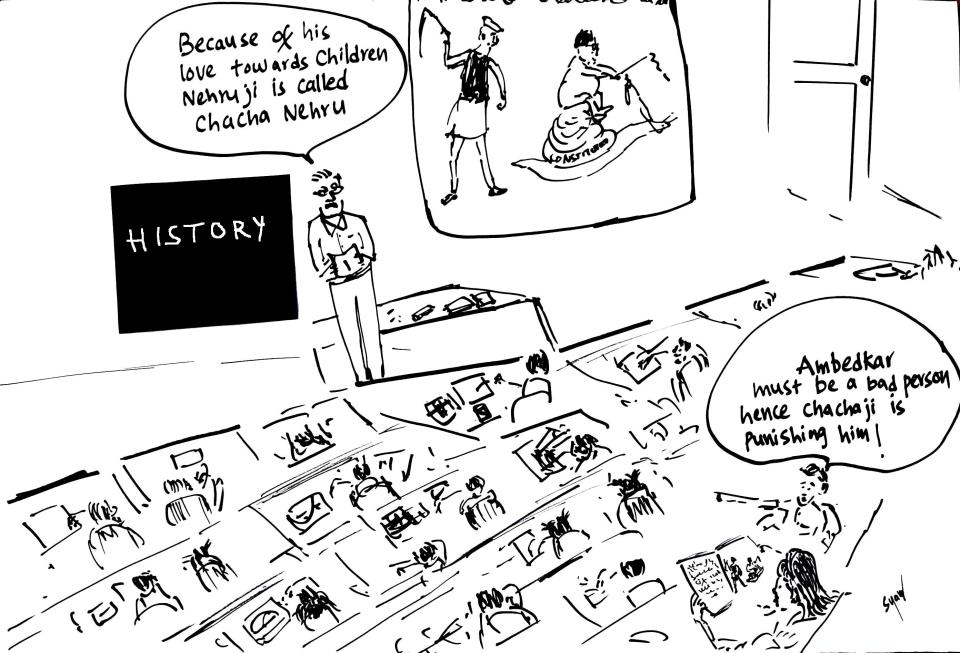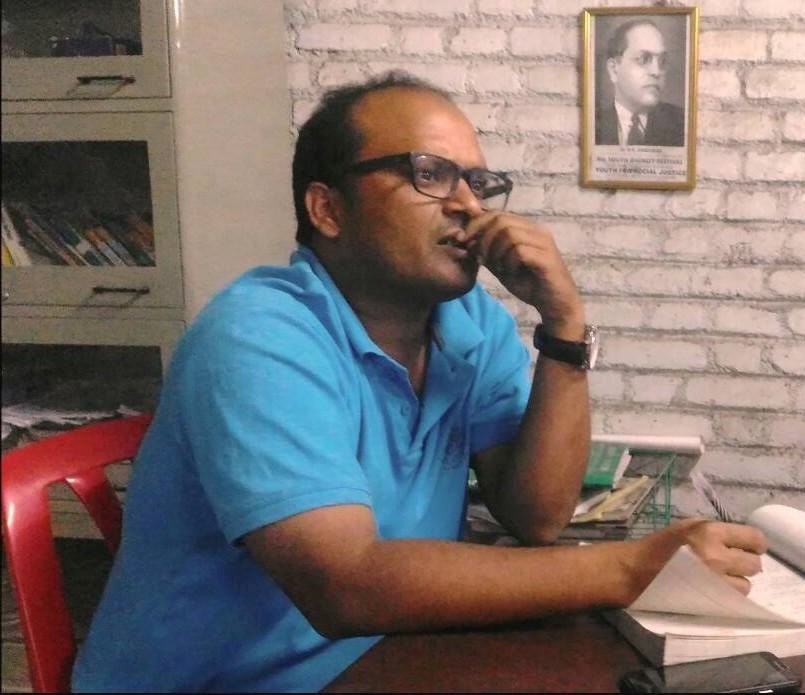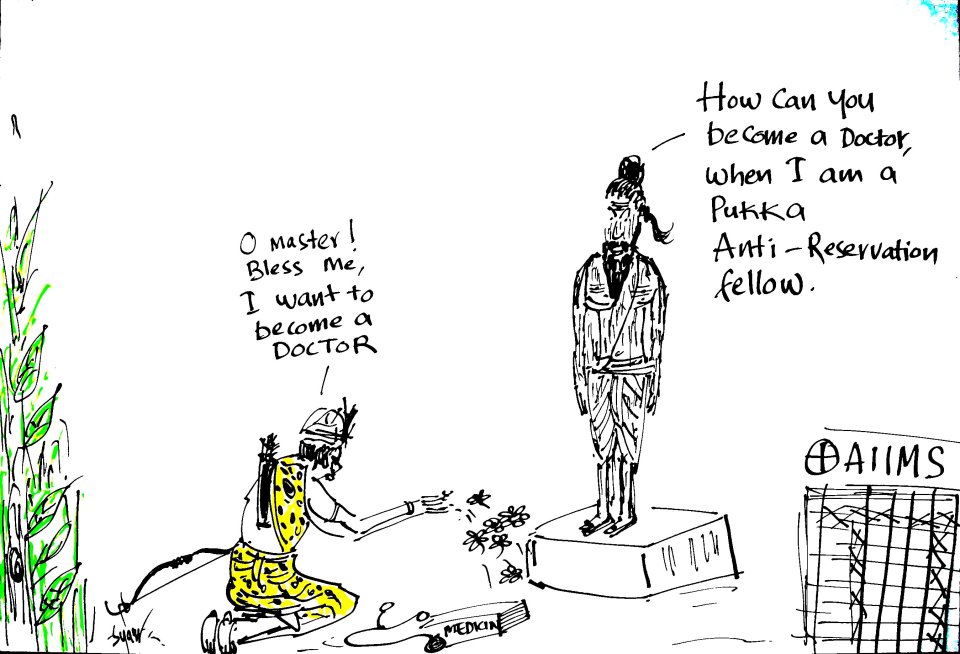Dr. N. Sukumar
The cartoon controversy has exposed the deeply divided faultlines in the sarkari academia which has gone into a damage control mode. A brief glance through all the news (both electronic and print), blogs, facebook chatter etc reveal the deep anguish at the frittering away of “academic freedom”. One appreciates the immense labour to make social sciences textbooks more child-friendly, to inculcate critical and creative thinking rather than promote learning by rote. In this context, images play a crucial role.

However, reading against the grain, certain questions need to be pondered over. Is the dialogic space within the classroom value-free? An Emphatic No. Despite the provisions of the RTE Act, many leading public schools in Delhi refuse to admit Muslim children. How many SC/ST children are into CBSE, ISCE, International Baccalaureate, and other elite schooling systems? The documentary, ‘India Untouched’, reflected the state of education in Bharat. Hailing from a small village wherein caste was a lived reality, the constitutional provisions enabled me to access higher education in an ’eminent’ academic institution. All sorts of ‘progressive’ theories were discussed from Plato, Marx to Gandhi but Ambedkar was the missing ideology. This is the academic freedom which nurtured and continues to operate in the classroom for many decades.
It was in the space outside the classroom where I was exposed to certain radical ideologies including Ambedkarism. Similarly, more than a decade of teaching in a ‘premier’ institution located in the national capital, I realized the Janus face of caste. For public consumption, caste needs to be debated and questioned and privately, the attempt is to shore up the brahaminical apparatus of academia. When a course on ‘Dalit Politics in India’ was introduced for M.Phil students, eight amongst them expressed a desire to conduct further research on this theme. A ‘progressive’ professor was astounded as to why the research agenda shifted from political theory to dalit politics. Hence, the site of the classroom is conflict ridden between the teacher and the taught. How does one locate any cartoon or imagery in the classroom? Hypothetically, if the textbooks were to contain paintings by M.F. Hussain, will the politics be different? Karamchedu, Jhajjer and Khairlanji are signposts of democratic struggles. Does our pedagogy reflect these concerns? The educational space is not beyond the social and political space. Similarly, our teaching community also does not exist in a vacuum. One needs only to interact with students from SC/ST/OBC communities who are at the receiving end of the injustices meted out by the casteist mindscapes. The nature of the classroom is exclusive, partisan, humiliating, creating a stigmatized space. No wonder that in many institutions of ‘higher learning’ in India, students are forced to kill themselves, to escape the dishonour which they experience in the classroom.
Power cannot be reduced to just the exercise of political authority but is also reflective of social sanctions and sanctities. The manufacturing of knowledge exists within a certain discursive framework which by its very nature creates an ‘other’. The political struggles of the last century from Phule till date challenged the meta-narratives of the ‘idea of India’. The process led to the emergence of symbols and icons which nurtured and strengthened the self-respect of the ‘other’. No longer are the marginalized people willing to subsist on charity but rather they demand a structural share in the national imagery. The dalits have made powerful and effective use of symbols to negotiate their space. The icon of Ambedkar with the copy of the Indian constitution occupies a pride of place in the dalit pantheon and is visible even in small hamlets across the country. The battle cry of the conscientized dalit is “humko hamare Baba ka adhikaar chahiye”. Thus for the average dalit, the idea of Ambedkar is co-terminus with the constitution It is difficult to fathom that the current generation of dalits will remain immune to any depiction or interpretation of Ambedkar’s images.
It is one thing to mention that both Nehru and Ambedkar enjoyed a good joke or had better sense of humour then their political descendants. However, the making of the constitution, in the Indian context was a gigantic task involving people with multiple ideologies and interests. Ambedkar accepted the arduous nature of the mission and the difficulty in creating a rational, secular structure, an antithesis to the bramhinical body politic. Nowhere is this better reflected than in the controversy generated by the Hindu Code Bill. Unfortunately, the ‘progressive’, ‘liberal’ and ‘secular’ Nehru miserably failed in convincing his own coterie and as a result, Ambedkar resigned from the law ministry. Does any cartoon reflect this hullabaloo?
What is very baffling is the appropriation of Ambedkar by the ‘left- progressive’ intellectuals! So far, Ambedkar is only the proponent of reservations and hence demonised by mainstream Indian society. His statues are demolished and people are killed if they espouse his ideology. Suddenly, the reductionist reading of Ambedkar has undergone a sea change and all sorts of virtues are being associated with him. Why this unexpected transformation? We should appreciate dalit mobilization and the dalit leadership which made Ambedkar kosher for the academia. When a dalit political party manages to rule the largest state in India, how can his ideology be neglected? The bramhinical media is compelled to recognize their existence. The labels of ‘rationality, logic, liberal, freedom of speech etc fly thick and fast but why choose a particular cartoon which neither adds to the debate nor promotes creative thinking.
The above cartoon was posted on Facebook and is quite appropriate to discuss the politics around caste and food and social space. Will our rational and logical experts include this in the Sociology textbook? It is extremely unpalatable as it confronts cow nationalism.
The current scenario of one step forward and two steps back is very hilarious. The minute there is any disagreement with any policy initiative, the government goes on the defensive rather than critically engaging with society. A healthy criticism is the lifeblood of democracy but the question is: who is undertaking the critique, its time and context. When the entire discourse is sponsored by a group which prides itself on being liberal, while promoting its own coterie, closely guarding its ranks against any interlopers, questions will be asked by those who scramble to be a part of the structure.
N. Sukumar teaches Political Science at the Department of Political Science, Delhi University. Email: suku69@yahoo.com
Cartoon by Unnamati Syama Sundar.










